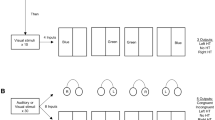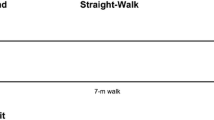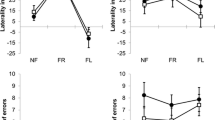Abstract
Many daily activities require separate tasks of the arms and legs to be performed together, as in driving where one foot controls the accelerator, one arm steers, and the other arm and foot shift gears and clutch. Strategies and underlying mechanisms for attention allocation and task prioritization have been explored in standing and walking while performing a manual or cognitive task. These studies reveal a task-related strategy that often, but not always, prioritizes the lower limb task of walking. However, in the absence of locomotion and gait-related postural control, as in sitting, multi-limb dual-task strategies are largely unexplored. Therefore, to characterize dual-task interference of arm and leg tasks during a driving-like activity, seated participants were assessed for the interference effect on hand velocity and movement time of a three-phase reach task and on the error in tracking of a foot-pedal ramp-tracking task. We found that the dual-task cost to reaching shown as decreases in reach performance differed among the three phases, that the cost to foot-pedal tracking also differed by phase, and that the between-task trade-off and prioritization strategy varied between the steep and gradual tracking ramps. Therefore, we propose that attention to concurrent reaching and foot-pedal tracking was flexibly allocated based on phase of the tasks.




Similar content being viewed by others
References
Bloem BR, Valkenburg VV, Slabbekoorn M, Willemsen MD (2001) The multiple tasks test: development and normal strategies. Gait Posture 14:191–202
Boisgontier MP, Beets IAM, Duysens J, Nieuwboer A, Krampe RT, Swinnen SP (2013) Age-related differences in attentional cost associated with postural dual tasks: increased recruitment of generic cognitive resources in older adults. Neurosci Biobehav Rev 37:1824–1837
Brackstone M, McDonald M (2007) Driver headway: how close is too close on a motorway? Ergonomics 50:1183–1195
Diermayr G, McIsaac TL, Kaminski TR, Gordon AM (2011) Aging effects on object transport during gait. Gait Posture 34:334–339
Dressel J (2008) Measuring dual task cost using the performance operating characteristic: the effect of emotional words on one’s functional field of view Doctoral Dissertation 3315981. University of Kansas, Kansas
Federal Highway Administration (2012) Highway statistics 2012—distribution of licensed drivers. http://www.fhwa.dot.gov/policyinformation/statistics/2012/dl20.cfm. Accessed June 06 2014
Fitch GA et al (2013) The impact of hand-held and hands-free cell phone use on driving performance and safety-critical event risk. National Highway Traffic Safety Administration, Washington, DC
Gysin P, Kaminski TR, Hass CJ, Grobet CE, Gordon AM (2008) Effects of gait variations on grip force coordination during object transport. J Neurophysiol 100:2477–2485
Janssen CP, Brumby DP, Garnett R (2012) Natural break points: the influence of priorities and cognitive and motor cues on dual-task interleaving. J Cogn Eng Decis Making 6:5–29
Kahneman D (1973) Attention and effort. Prentice-Hall series in experimental psychology. Prentice-Hall, Englewood Cliffs, NJ
Kelly VE, Janke AA, Shumway-Cook A (2010) Effects of instructed focus and task difficulty on concurrent walking and cognitive task performance in healthy young adults. Exp Brain Res 207:65–73
Kelly VE, Eusterbrock AJ, Shumway-Cook A (2013) Factors influencing dynamic prioritization during dual-task walking in healthy young adults. Gait Posture 37:131–134
Laessoe U, Hoeck HC, Simonsen O, Voigt M (2008) Residual attentional capacity amongst young and elderly during dual and triple task walking. Hum Mov Sci 27:496–512
Lajoie Y, Teasdale N, Bard C, Fleury M (1993) Attentional demands for static and dynamic equilibrium. Exp Brain Res 97:139–144
Marteniuk RG, MacKenzie CL, Jeannerod M, Athenes S, Dugas C (1987) Constraints on human arm movement trajectories. Can J Psychol 41:365–378
Meyer DE, Kieras DE (1997a) A computational theory of executive cognitive processes and multiple-task performance: part 1. Basic mechanisms. Psychol Rev 104:3–65
Meyer DE, Kieras DE (1997b) A computational theory of executive cognitive processes and multiple-task performance: part 2. Accounts of psychological refractory-period phenomena. Psychol Rev 104:749–791
Nagasaki H (1989) Asymmetric velocity and acceleration profiles of human arm movements. Exp Brain Res 74:319–326
National Highway Traffic Safety Administration (2014) Distracted driving facts and statistics. US Department of Transportation. http://www.distraction.gov/content/get-the-facts/facts-and-statistics.html. Accessed 23 December 2014
Navon D, Miller J (2002) Queuing or sharing? A critical evaluation of the single-bottleneck notion. Cogn Psychol 44:193–251
Norman DA, Bobrow DG (1975) On data-limited and resource-limited processes. Cogn Psychol 7:44–64
Pashler H (1994) Dual-task interference in simple tasks: data and theory. Psychol Bull 116:220–244
Plummer-D’Amato P, Cohen Z, Daee NA, Lawson SE, Lizotte MR, Padilla A (2012) Effects of once weekly dual-task training in older adults: a pilot randomized controlled trial. Geriatr Gerontol Int 12:622–629
Rapp MA, Krampe RT, Baltes PB (2006) Regular research article: adaptive task prioritization in aging: selective resource allocation to postural control is preserved in Alzheimer disease. Am J Geriatr Psychiatry 14:52–61
Schumacher EH, Seymour TL, Glass JM, Fencsik DE, Lauber EJ, Kieras DE, Meyer DE (2001) Virtually perfect time sharing in dual-task performance: uncorking the central cognitive bottleneck. Psychol Sci 12:101–108
Shumway-Cook A, Woollacott M, Kerns KA, Baldwin M (1997) The effects of two types of cognitive tasks on postural stability in older adults with and without a history of falls. J Gerontol Ser A-Biol Sci Med Sci 52A:M232–M240
Stutts J, Feaganes J, Reinfurt D, Rodgman E, Hamlett C, Gish K, Staplin L (2005) Driver’s exposure to distractions in their natural driving environment. Accid Anal Prev 37:1093–1101
Supuk T, Bajd T, Kurillo G (2011) Assessment of reach-to-grasp trajectories toward stationary objects. Clin Biomech 26:811–818
Van Mier H, Hulstijn W, Petersen SE (1993) Changes in motor planning during the acquisition of movement patterns in a continuous task. Acta Psychol 82:291–312
van Vliet P, Pelton TA, Hollands KL, Carey L, Wing AM (2013) Neuroscience findings on coordination of reaching to grasp an object: implications for research. Neurorehabil Neural Repair 27:622–635
Wickens CD (2002) Multiple resources and performance prediction. Theor Issues Ergon Sci 3:159–177
Woollacott M, Shumway-Cook A (2002) Attention and the control of posture and gait: a review of an emerging area of research. Gait Posture 16:1–14
Yogev-Seligmann G, Hausdorff JM, Giladi N (2008) The role of executive function and attention in gait. Mov Disord 23:329–342
Yogev-Seligmann G, Hausdorff JM, Giladi N (2012) Do we always prioritize balance when walking? Towards an integrated model of task prioritization. Mov Disord 27:765–770
Acknowledgments
We thank G. Diermayr, D. Nilsen, and Y.-C. Hung for helpful comments on early versions of the manuscript. This work was supported by a Teachers College Dean’s Grant to T. L. McIsaac and the Chulalongkorn University Instructor Development Grant to B. Benjapalakorn.
Conflict of interest
The authors report no conflict of interest in this work.
Author information
Authors and Affiliations
Corresponding author
Rights and permissions
About this article
Cite this article
McIsaac, T.L., Benjapalakorn, B. Allocation of attention and dual-task effects on upper and lower limb task performance in healthy young adults. Exp Brain Res 233, 2607–2617 (2015). https://doi.org/10.1007/s00221-015-4333-6
Received:
Accepted:
Published:
Issue Date:
DOI: https://doi.org/10.1007/s00221-015-4333-6




